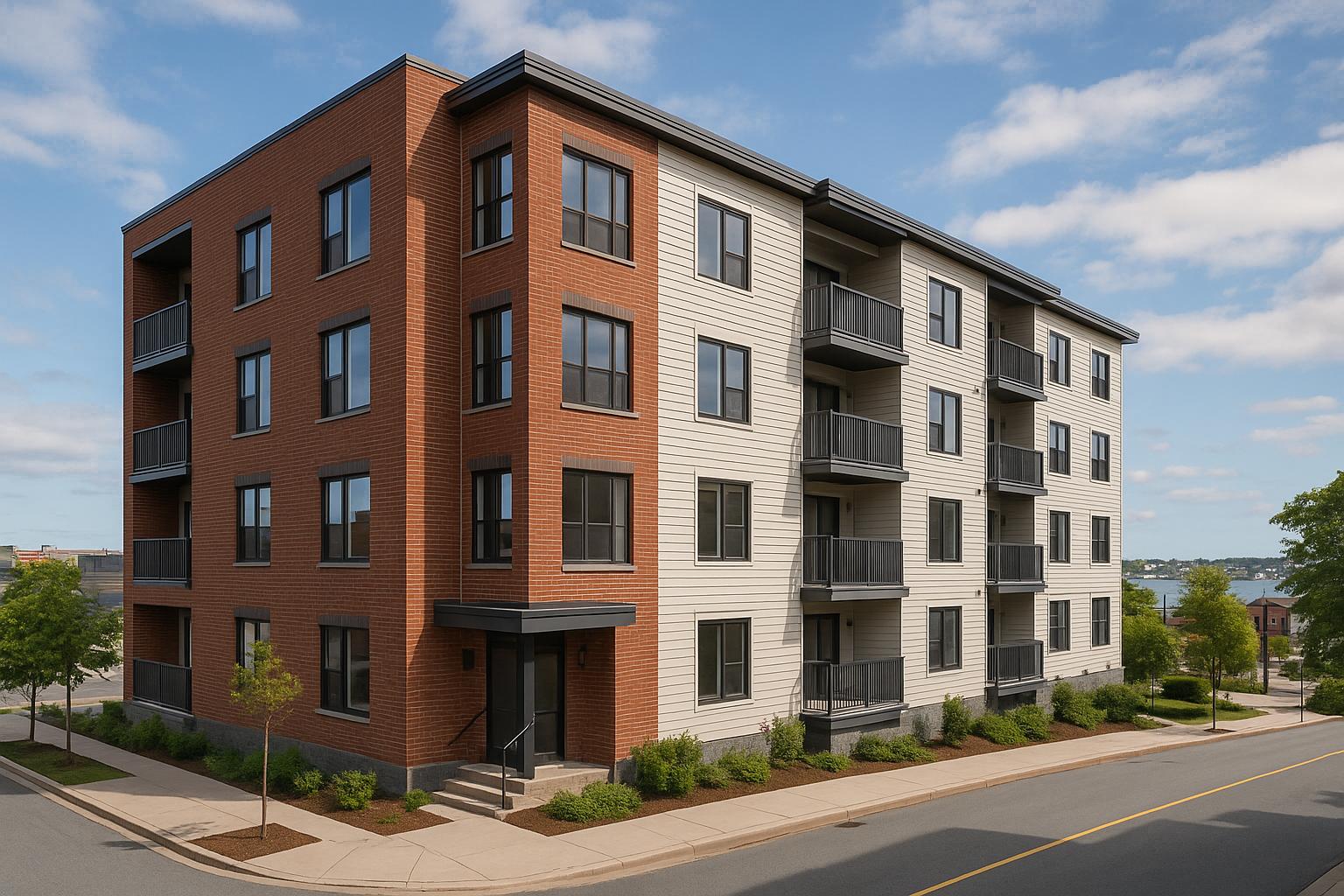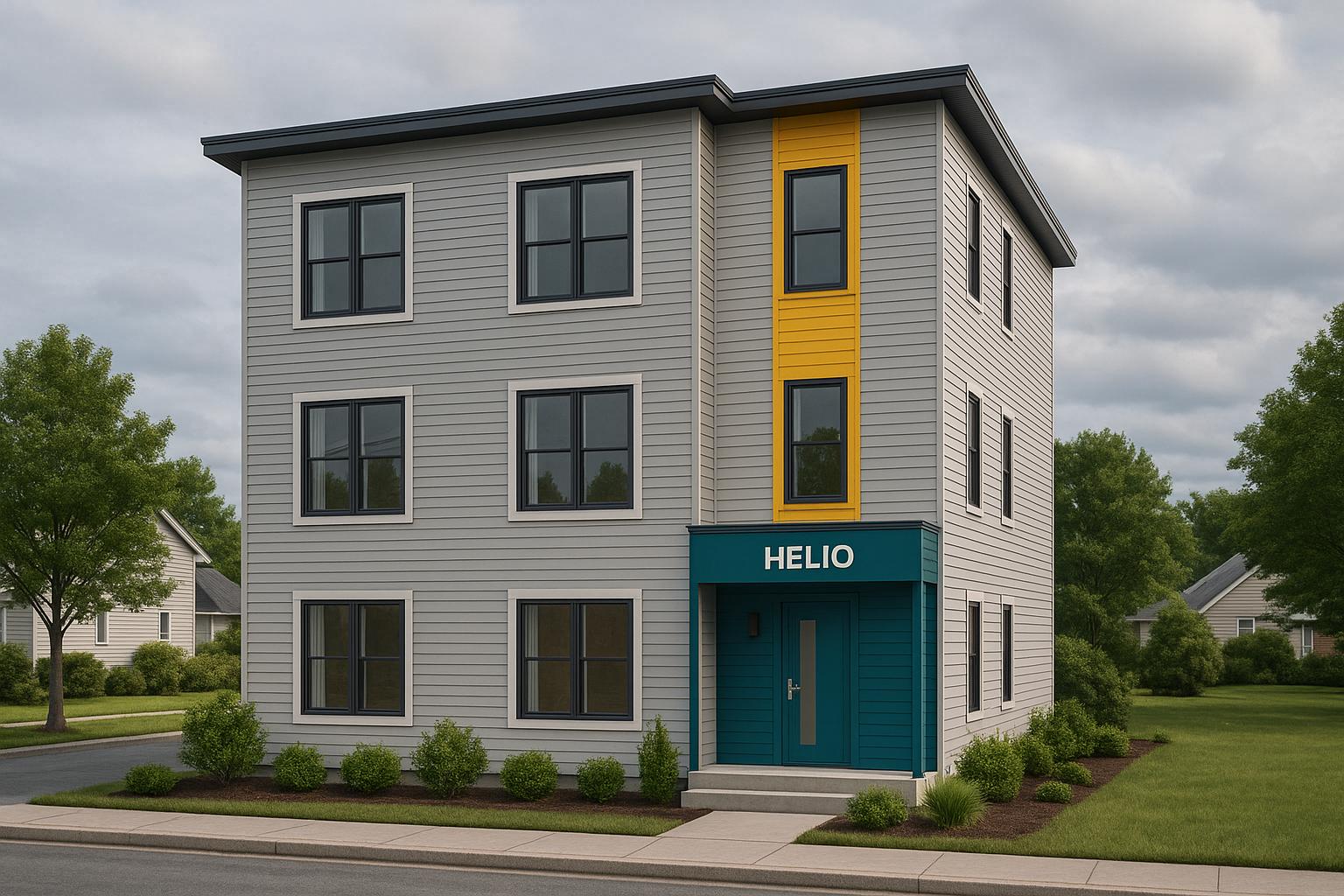Navigating COR zoning rules in Nova Scotia can be tricky, especially with width and depth limits that directly impact multi-unit rental projects. These restrictions, designed to maintain neighbourhood character, often reduce usable space, limiting unit counts and rental income. However, applying for a variance can help you maximize your land's potential.
Key Takeaways:
- Variances are often needed for irregular lots, corner properties, or challenging terrain.
- Setback rules can shrink building areas, increase costs, and complicate financing.
- A strong variance application should include clear financial benefits, community benefits, and well-prepared documentation.
- Integrated design-build teams streamline the process, saving time and reducing risks.
With proper planning and a well-documented approach, securing a variance can turn zoning challenges into opportunities for better project outcomes.
Zoning By Laws and Minor Variances
When You Need a Width/Depth Variance
Following the overview of COR setbacks, let’s dive into the specific situations where a variance becomes necessary.
What Leads to Variance Requests
Certain lot characteristics can make adhering to setback standards difficult. For example, irregularly shaped lots - those with narrow frontages, odd angles, or uneven contours - often require variances to meet setback rules while still achieving the desired unit count. Corner lots add another layer of complexity, as they need to meet setback requirements on multiple sides, which can limit the potential for multi-unit developments.
In Halifax, older subdivisions present their own set of challenges. Many lots were subdivided decades ago, long before today’s building standards existed. While these lots may technically be buildable, they often conflict with current COR restrictions, making development tricky. On top of that, natural features like steep slopes, rocky terrain, or wetlands can further restrict how a lot can be used.
Sometimes, the project itself demands a larger building footprint than zoning allows. In these cases, securing a variance becomes essential to maximize unit count and, ultimately, rental income.
Parking and amenity requirements add to the complexity. COR zoning includes specific rules for parking ratios and outdoor spaces. On smaller or oddly shaped lots, meeting these requirements while adhering to setback rules can force tough decisions - such as whether to prioritize parking compliance or make full use of the available land.
How Restrictions Impact Finances
Setback restrictions can shrink the usable building area, which reduces unit density and, in turn, rental revenue.
These restrictions also lead to less efficient building designs. Working around strict setback rules often results in layouts that are more expensive on a per-unit basis, as they fail to make the most of the available space.
Securing a variance can significantly improve a project’s financial potential. By allowing a more efficient site layout, a variance can support additional units, boosting rental income and improving cash flow. In many cases, this can lead to a better return on investment.
However, the variance approval process can delay construction and, consequently, the start of rental income. That said, if the variance enables a design that improves long-term profitability, the delay may be well worth it.
Setback restrictions also affect financing. Lenders base their decisions on a property’s income potential, and projects constrained by strict setbacks might not generate enough cash flow to secure favourable terms. On the other hand, a successful variance can improve a property’s debt service coverage ratio, making it easier to qualify for financing programs like CMHC MLI Select. This program offers up to 95% financing for energy-efficient projects, which can be a game-changer for developers.
Next, we’ll explore real-world examples from Nova Scotia, where securing a variance made a significant difference in project outcomes.
Real Variance Success Stories in Nova Scotia
Variance approvals in Nova Scotia have reshaped projects, increasing both unit counts and financial performance.
Project Results: Before and After Variances
Take a Halifax Peninsula fourplex as an example. By securing a variance to reduce rear setbacks, the project added an extra unit. While this adjustment extended the timeline, the additional unit boosted the annual ROI to an impressive range of 12% to 20%.
What Made These Applications Successful
Several factors often contribute to the success of variance applications:
- Strong financial reasoning: A clear demonstration of how design adjustments improve rental income and overall investment returns.
- Neighbourhood compatibility: Showing that the revised setbacks blend well with the surrounding area.
- Professional presentation: Detailed architectural drawings, thorough site surveys, and engineering reports help municipal planning teams see the proposal's benefits.
- Minimizing impact on neighbours: Features like strategic window placement and landscaping buffers reduce any negative effects on nearby properties.
- Alignment with municipal goals: Highlighting how the project supports housing supply growth and thoughtful, context-sensitive densification.
An integrated design-build team - combining planners, architects, engineers, and construction experts - can create a well-rounded proposal that meets municipal requirements.
Since review timelines differ by municipality, property owners should plan for potential delays when scheduling their projects.
Up next, we’ll walk you through the application steps to help turn these success stories into success for your own projects.
sbb-itb-16b8a48
How to Get Your COR Variance Approved
Securing approval for your variance requires careful planning and a strong, well-documented application. It’s all about demonstrating the value of your proposal while ensuring every detail is accurate and complete.
Variance Application Steps
Start by reaching out to your municipal planning office to understand their specific requirements. This includes the exact documentation they need, any associated fees, and the expected processing timeline. Typically, you’ll need to submit:
- A completed application form
- A current property survey
- Supporting documents
- A written justification for the variance
- Proof of property ownership
You’ll also need to pay the application fee upfront. Make sure to confirm the review timeline so you can plan your project accordingly.
What Makes a Strong Application
Once you have the required documents, focus on building a case that stands out. A well-crafted written justification is crucial. Explain clearly how the variance benefits the community and address any potential concerns head-on. For example, if you’re requesting a variance to add a rental unit, include data showing how this will help meet local housing needs.
Your application should also feature professional site plans that detail current conditions and proposed changes. Include elevation drawings to show how your design fits into the neighbourhood’s character, and landscape plans that demonstrate strategies for maintaining privacy, such as buffering or screening. Technical reports, such as drainage studies or structural analyses from a licensed engineer, can further solidify your case.
Additionally, consider potential concerns from neighbours. Proactively address these by including thoughtful design elements, such as strategic window placement or landscaping, to minimize impacts on privacy and maintain the community’s character.
How Integrated Design-Build Helps
A strong application is just the beginning. Adopting an integrated design-build approach can simplify the entire process and increase your chances of success. Unlike traditional methods that require juggling multiple professionals, an integrated design-build firm like Helio Urban Development handles everything under one roof, saving time and reducing stress.
With an integrated team, architects and engineers collaborate from the start, ensuring all aspects of your variance documentation - design details, structural feasibility, and technical requirements - are consistent and aligned. This streamlined approach can deliver complete application packages 20% faster than traditional methods [1].
Another major advantage is clear, coordinated communication. Working with a single point of contact means you can get quick answers or clarifications during the municipal review process, avoiding delays caused by miscommunication between separate consultants [1]. Plus, having the construction team involved early allows them to flag potential site layout issues and propose solutions before the documents are finalized [2].
Integrated vs Multiple-Contract Construction
When navigating COR zoning variances, your choice of construction approach can determine the success - or failure - of your project. The old-school method of hiring separate contractors for each phase often leads to coordination nightmares, jeopardizing both variance approvals and construction timelines.
Main Differences in Cost and Timeline Control
The gap between the traditional multiple-contract approach and an integrated design-build model becomes glaringly obvious when zoning challenges enter the picture. With traditional methods, you’re left managing separate architects, engineers, planners, and builders who often don’t collaborate effectively. Here’s how the two approaches stack up:
| Factor | Multiple-Contract Approach | Integrated Design-Build |
|---|---|---|
| Cost Certainty | Budget overruns of 30–60% | Fixed-price construction at $160,000/unit |
| Timeline Control | 12–18 months with frequent delays | 6 months guaranteed with penalty protection |
| Coordination | 6+ separate professionals to manage | Single point of accountability |
| Variance Support | Inconsistent documentation and conflicting advice | Coordinated application with aligned expertise |
The numbers speak for themselves. Property owners using the traditional approach often lose an estimated $47,000 in wasted time due to poor coordination. Miscommunication between architects, engineers, and contractors can derail variance processes and inflate costs.
Helio Urban Development solves this issue by combining planners, architects, engineers, and construction teams into one unified company. This means your variance application benefits from a team that works together seamlessly, with every professional fully aware of how their role impacts the others.
The financial advantage is clear. Traditional methods leave you vulnerable to fluctuating costs, while integrated construction offers fixed guarantees. For example, Helio backs its 6-month timeline with penalties of up to $1,000 per day for delays - a safeguard that could save property owners up to $8,800 per month in lost rental income.
Why Integration Helps Win Variances
Municipal planners are far more likely to approve variance applications that show clear coordination and realistic execution plans. When your application comes from disjointed teams, inconsistencies between designs, structural analyses, and construction feasibility can raise red flags, stalling or even halting approval.
Integrated teams eliminate this risk by ensuring complete alignment from the start. The architect drafting your variance request collaborates directly with the engineer approving the drawings and the construction team building the project. Helio’s co-founder, Yuan He, has developed advanced scheduling systems to prevent the delays that often plague traditional projects. These tools ensure variance applications include timelines municipal authorities can trust.
The benefits of integration extend beyond paperwork. During municipal reviews, questions or clarifications can be resolved quickly through single-point accountability, rather than bouncing between multiple consultants. This streamlined communication prevents the delays that often drag out approval timelines.
As Lloyd Liu, Helio’s CEO and former investment banker, puts it: "I personally guarantee every timeline because I’ve felt the pain of construction delays."
This level of accountability is simply unattainable with a fragmented approach.
Integrated teams also bring proactive problem-solving to the table. By involving construction experts during the variance stage, potential site challenges can be identified and addressed early - long before they become costly issues during the build phase.
The results speak volumes. Helio currently has 31 units under construction across Nova Scotia, with an additional 131 units in planning. Serving property owners in municipalities within 90 minutes of Halifax, Helio’s track record proves that integrated approaches don’t just promise better coordination - they deliver it consistently across diverse projects and locations.
Getting the Most from Your Land Under COR Zoning
Navigating COR zoning in Nova Scotia can open doors for multi-unit developments, but it also comes with its share of challenges. Knowing when width and depth restrictions demand variances - and how to handle the approval process - can mean the difference between maximizing your land's potential and falling short.
Spotting zoning conflicts early is key. It gives your team the chance to tweak designs to fit COR limits or build a persuasive case for variances [2][4]. This forward-thinking approach saves time and avoids costly setbacks.
Clear communication and well-coordinated planning are essential for smooth variance applications [2][3][4]. When every professional involved understands how their roles align, it eliminates the kind of missteps that can raise concerns with municipal authorities.
Another advantage of an integrated team is locking in a guaranteed maximum price early on. This proactive step shifts risks away from the property owner, helping to keep both budgets and timelines on track - even when zoning challenges emerge [4][5].
Time is often of the essence. By overlapping design and construction phases, integrated teams can start foundational work when designs are only 30–40% complete. This approach trims project timelines significantly compared to traditional methods [3][4][5]. For projects with tight approval deadlines or market pressures, this efficiency can make all the difference in meeting financial and operational goals.
Streamlined communication is another key benefit. With a single point of contact managing the variance application and construction process, property owners can avoid the confusion that comes from coordinating advice from multiple professionals. This consistency prevents miscommunication and keeps projects moving forward smoothly [3][4].
Integrated teams also focus on long-term outcomes. They assess designs for both cost efficiency and operational success [5]. This ensures that COR-compliant land use is maximized while keeping expenses under control - an essential strategy for boosting rental property returns and justifying variances.
To succeed under COR zoning, it’s crucial to understand your land’s limitations, strategically apply for variances that enhance financial returns, and present well-prepared applications. By adopting an integrated approach, you can turn a traditionally complex, high-risk process into a structured path toward getting the most from your property investment.
FAQs
What challenges do property owners face when applying for a COR width or depth variance in Nova Scotia?
Navigating the process of applying for a COR width or depth variance in Nova Scotia can feel daunting, largely because of the intricate zoning regulations and the varying ways municipal authorities might interpret them. This variability can make the process seem unpredictable.
Applicants often encounter delays and are required to present compelling evidence to support their request. This typically involves showing that the proposed variance won’t harm neighbouring properties or go against the public interest. While the process is detailed and thorough, careful preparation can help you handle these hurdles with greater confidence.
How can working with an integrated design-build team help secure a zoning variance for a multi-unit rental project?
An integrated design-build team can significantly improve your odds of obtaining a zoning variance by fostering early collaboration among designers, builders, and other essential stakeholders. This teamwork helps spot potential zoning challenges early on and craft solutions that align with local regulations and land use policies.
By ensuring clear communication and efficient decision-making, the team presents a unified and well-prepared case to municipal authorities. This approach not only minimizes delays but also showcases a high level of professionalism and responsibility, strengthening your variance application and boosting the chances of approval.
What financial advantages can property owners gain by obtaining a variance under COR zoning regulations in Nova Scotia?
Obtaining a variance under COR zoning regulations can open up opportunities for property owners to make more efficient use of their land. For instance, it could allow you to increase the number of rental units or modify building dimensions, potentially boosting rental income and improving your overall return on investment.
Beyond financial gains, a thoughtfully planned variance can help you sidestep expensive delays or the need for redesigns, keeping your project on schedule and within budget. By tapping into your property's full potential while staying compliant with zoning rules, you can enhance its long-term value and profitability.



